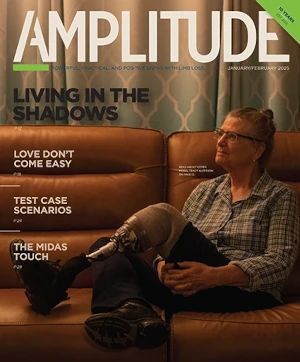Last January, Amplitude shared a set of expectations for amputees in 2021. They weren’t predictions, per se; more like educated guesses about various cultural, technological, and political trends. How do those trendlines look today, 12 months down the road? And what do we expect for 2022? Here’s a look back and a peek ahead.
Portals to Participation
What we expected: “Many organizers of support group meetings and other events have discovered that much of the information they offer can be delivered effectively online…. Many will continue to offer their online services after pandemic restrictions pass.”

What happened: Online amputee gatherings continued to grow by leaps and bounds in 2021. Zoom and similar platforms enabled support groups to meet more frequently than ever while casting a wider geographic net. The Amputee Coalition held its Advocacy Forum and national conference virtually for a second straight year, and adaptive sports organizations such as Move United and Angel City Sports rolled out new virtual programs to support stay-at-home fitness.
What to expect in 2022: Digital support-group platforms are here to stay. They’ve become a vital connection for thousands of amputees who can’t easily attend in-person meetings. But we expect large in-person events to make a comeback in 2022, as long as public health conditions permit.
More Visibility in Hollywood
What we expected: “The USC Annenberg School for Communication and Journalism found an increase in the number of [film] leads and co-leads with disabilities…. While there’s still a long way to go to achieve equal representation and opportunities, the trend seems to be positive.”

What happened: People with disabilities continued to garner more screen time. According to the Geena Davis Institute’s annual survey, nearly one in five major television characters were portrayed as having a disability (up from zero percent in 2016). Zyra Gorecki crossed a major threshold on NBC’s La Brea, becoming the first amputee with a central role on a network TV series. On the big screen, Pixar’s Luca garnered headlines for its sensitive depiction of congenital limb difference.
What to expect in 2022: Amputee actors will star in two upcoming projects—Alaqua Cox in Echo, a Marvel Universe series on Disney+, and John Lawson in the Pet Sematary prequel—and Gorecki will return for season 2 of La Brea. However, RespectAbility cautions that “[people with disabilities] have to be included in an authentic way, telling diverse, complex stories of the disability experience.”
The Rise of Telehealth
What we expected:“There was an unprecedented increase in telemedicine use…. Its benefits—along with telehealth’s potential to lower the overall costs of healthcare—ensure future efforts to overcome any obstacles to its expanded use.”

What happened: By mid-2021, according to the American Hospital Association, telehealth had stabilized at about 15 percent of total visits across all medical specialties. With respect to limb loss, telemedicine became more common in post-amputation wound care, pain control, and mental health counseling, as well as pre-amputation consulting. But in-person visits remained the norm among prosthetists: Only 19 percent deemed telehealth “very important” in an O&P EDGE survey.
What to expect in 2022: The journal Physical Medicine & Rehabilitation recently bemoaned the lack of data on outcomes for amputees receiving virtual care. Two pilot studies commissioned by the American Orthotic and Prosthetic Association might yield some data this year about the extent and effectiveness of telehealth within O&P.
Enhanced Bionics
What we expected: “Improved technology and medical procedures that better connect the body and the brain may improve patients’ control of their prosthetic devices so that the devices can function more realistically and provide users a higher degree of feeling.”

What happened: The pace of innovation continued accelerating. Key advances included the next-gen SENSY bionic leg, which gained limited FDA approval; the Cleveland Clinic’s new mind-controlled bionic arm; and breakthroughs in prosthetic exoskeletons, osseointegrated implants, and magnet-driven control mechanisms. New thresholds were also crossed in AMI surgery, which facilitates tighter integration between body and prosthesis.
What to expect in 2022: We’re awaiting research findings related to implantable sensors and neural interface systems, another important frontier in creating more responsive, naturalistic bionic limbs. BrainRobotics’ futuristic bionic hand is inching toward FDA approval, and the Atom Touch (a DARPA-funded bionic arm) is a year or two away.
Reduced Healthcare Disparities
What we expected: “Limb loss is more prevalent among people of color and people with lower incomes…. Black patients lose limbs at a rate triple that of others. Similar inequities have been found in many other areas of healthcare, and they will be fought against this year.”
What happened: The American Diabetes Association and American Heart Association released major studies that deepened our understanding of US amputation patterns; both found elevated rates of limb loss in rural areas and communities of color. Overall health disparities worsened last year, as the pandemic continued to disproportionately affect Black, Hispanic, and lower-income populations.
What to expect in 2022: The Limb Loss and Preservation Registry is close to launch. Whenever it goes live, it will yield new insights about who’s impacted by limb loss, where gaps in care exist, and how resources can be funneled to areas of acute need.
Political Accountability
What we expected: “During the 2018 midterm elections, voter participation for people with disabilities rose 8.5 percentage points…. This year offers a great opportunity for people with disabilities to flex their political muscle.”

What happened: The bipartisan Infrastructure Investment and Jobs Act included $2 billion to make US transit stations easier to navigate for people with mobility challenges. But two other major bills related to limb loss—the Amputation Reduction and Compassion Act and the Triple A Study Act—languished despite bipartisan support. And no states enacted new Fair Insurance for Amputee laws.
What to expect in 2022: As Amplitude went to press, Congress was considering legislative proposals to lower prescription drug costs, expand Medicaid eligibility, and authorize paid family leave. Any or all of these policies would improve health outcomes and quality of life for amputees.




